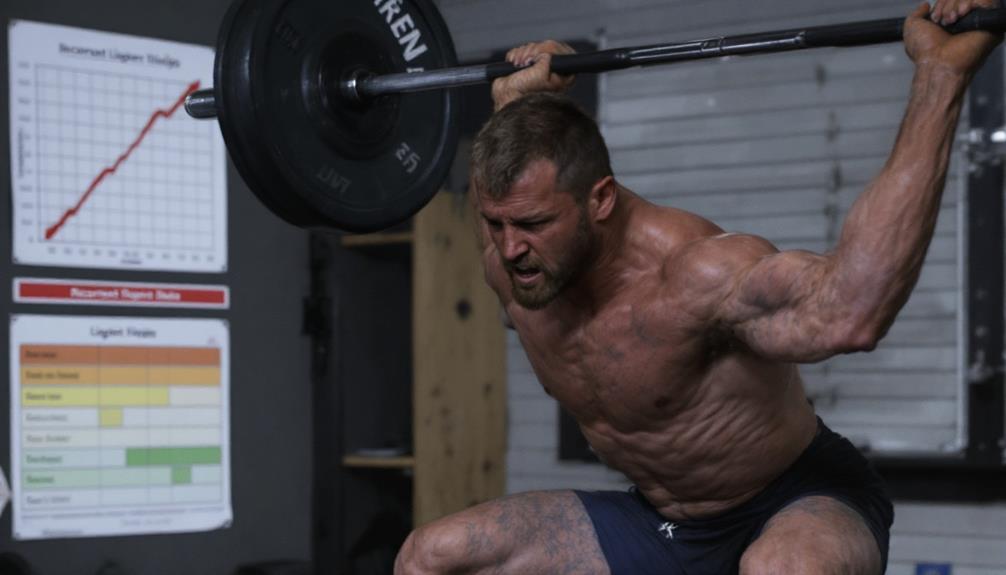Progressive advancement is a key principle in resistance training that involves gradually increasing the demands on your muscles. You can achieve this by adding weight, reps, or sets to your exercises over time. This approach helps you build strength, muscle mass, and improve overall fitness. By consistently challenging your body, you'll see continuous improvements in your physical performance and endurance. To implement progressive advancement effectively, start by evaluating your current strength levels, then gradually increase the difficulty of your workouts. Remember to maintain proper form and allow for adequate rest between sessions. Mastering this concept can reveal significant gains in your fitness journey.
Core Insight
- Progressive overload is a fundamental principle in resistance training that involves gradually increasing workout intensity.
- It typically involves incrementally increasing weight, frequency, or repetitions to continually challenge muscles.
- The goal is to consistently push the body beyond its current capacity, leading to increased strength and muscle growth.
- This method prevents plateaus by forcing the body to adapt to new, increasingly difficult demands.
- Progressive overload can be implemented through various means, including adding weight, increasing reps, or changing exercise variables.
Definition of Progressive Overload

Progressive overload is the key idea behind resistance training. It means gradually increasing the weight, frequency, or number of repetitions in your strength training routine. By consistently challenging your muscles over time, you can build strength, muscle mass, and overall fitness. Resistance tubes are a flexible tool to help with progressive overload, offering resistance options from 2 lbs to over 40 lbs.
The main idea is straightforward: to improve, you need to push your body a little more than it can currently handle. This doesn't mean you have to make big jumps in weight or reps every time you work out. Instead, focus on making small, steady improvements.
You can apply progressive overload in several ways:
- Increase the weight you lift.
- Add more repetitions.
- Do more sets.
- Shorten your rest time between sets.
- Enhance your exercise form and range of motion.
Benefits of Progressive Overload

Understanding progressive overload is key to unlocking its many benefits. When you regularly push your muscles to work harder, you will see real improvements in your fitness. Using muscle-building supplements can support your progressive overload efforts by helping with muscle recovery and growth. Here are some benefits of progressive overload:
- Increased muscle strength and size
- Improved endurance
- Better overall physical performance
Methods of Progressive Overload

Fitness enthusiasts have several simple ways to use progressive overload effectively. One common method is to increase the weight you lift. You can also add more repetitions or sets for each exercise. Shortening the rest time between sets is another way to make your workouts more intense. Using foam rollers can help with recovery, keeping your muscles healthy and flexible. This means you can train more often and effectively.
You can change the speed of your lifts, especially by slowing down the lowering phase to make it harder. Trying different exercises or improving your form can work your muscles in new ways. For some exercises, moving through a greater range of motion can also add difficulty. Lastly, you might consider working out more frequently, targeting specific muscle groups several times a week. By mixing these methods, you'll keep your body challenged and help it grow stronger over time.
Implementing Progressive Overload

To successfully use progressive overload, follow a simple plan. First, find out your current strength and endurance levels. This baseline will help you track your progress and decide when to make things more challenging. Just like choosing the right size for a compression sleeve, picking the right resistance is key for better performance and preventing injuries.
Next, pick a method of progressive overload that works for you and slowly add it to your routine. Always focus on maintaining good form and technique as you raise the demands on your body.
Here are three easy steps to implement progressive overload effectively:
- Keep a workout log to track your progress.
- Set clear and specific goals for each exercise.
- Change your training variables every 2-4 weeks.
Be patient and stay consistent. Your body needs time to adapt to the increased demands before you make further changes. Listen to your body and avoid pushing too hard too quickly to prevent injuries and burnout.
Common Mistakes to Avoid

Many fitness enthusiasts make mistakes when trying to gradually increase their workout intensity. These mistakes can slow down progress or even cause injuries. Here are three common errors and how to fix them:
| Mistake | Consequence | Solution |
|---|---|---|
| Increasing weight too fast | Risk of injury | Increase weight slowly |
| Ignoring proper form | Less effective workouts | Pay attention to technique |
| Working out too much | Burnout and hitting a plateau | Make sure to rest and recover |
Frequently Asked Questions
How Long Does It Take to See Results From Progressive Overload?
You'll typically see results from progressive overload within 4-8 weeks. However, individual factors like genetics, diet, and consistency play a role. Keep tracking your progress, and you'll notice strength gains and muscle growth over time.
Can Progressive Overload Be Applied to Bodyweight Exercises?
Yes, you can apply progressive overload to bodyweight exercises. You'll need to increase reps, sets, or difficulty of movements over time. Try adding variations, changing tempo, or incorporating resistance bands to keep challenging your muscles.
Is Progressive Overload Suitable for Elderly or Injured Individuals?
As you watch a gray-haired woman gracefully perform modified push-ups, you'll see that progressive overload can be suitable for elderly or injured individuals. You'll want to start slowly, focusing on proper form and gradually increasing difficulty as you're able.
How Often Should I Adjust My Workouts for Progressive Overload?
You should adjust your workouts for progressive overload every 2-4 weeks. Listen to your body and track your progress. When exercises become easier, it's time to increase weight, reps, or sets to keep challenging your muscles.
Can Progressive Overload Lead to Overtraining or Increased Injury Risk?
Like a car pushed too hard, you can overdo it. Yes, progressive overload can lead to overtraining or injury if you're not careful. You'll need to balance increasing intensity with proper rest and recovery to avoid burnout.

